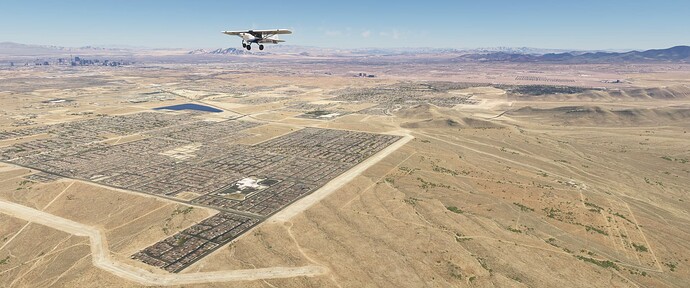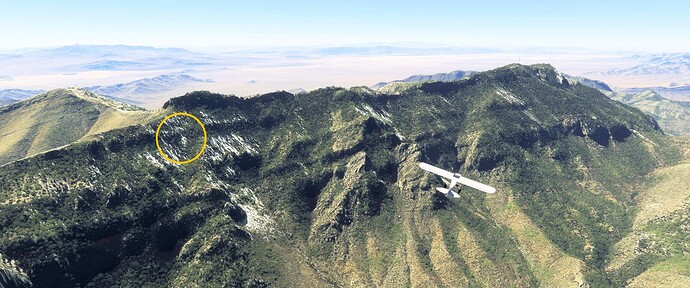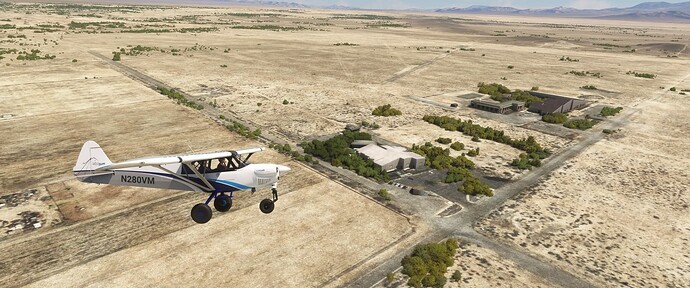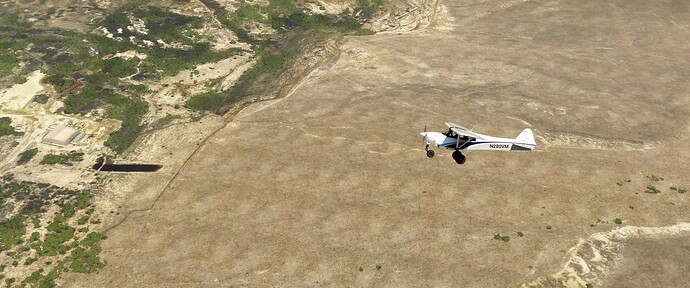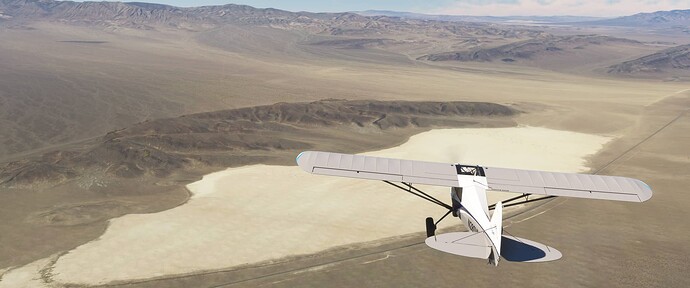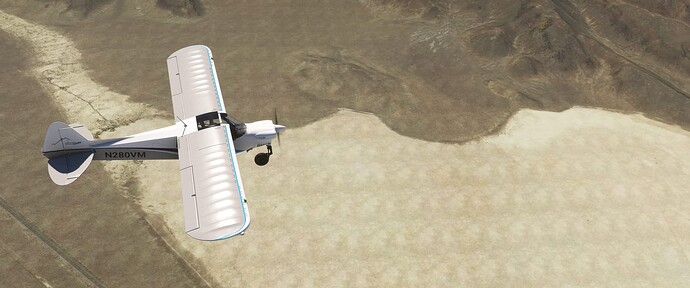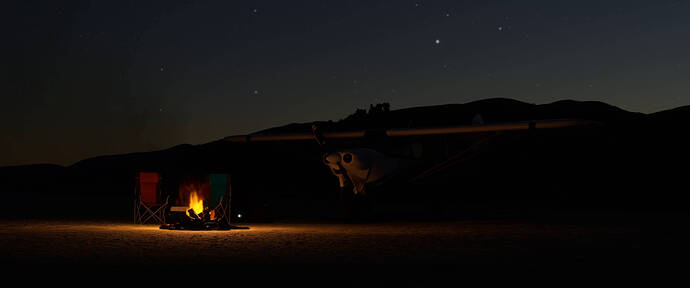Welcome back, everyone! We recently toured some abandoned airports and interesting sites northwest of Las Vegas in Southern Nevada. This was our first two-day tour, with an overnight campout on a remote dry lakebed. Grab a beverage or a snack and get comfortable: there’s lots see in the Mojave Desert!
For this tour we used the MonsterNX Cub modification by GotFriends, and we’ve both agreed that it’ll be our go-to machine for longer tours. Visibility from the cockpit is excellent, performance is pretty good, and the autopilot really helps fight fatigue. Having two people taking notes and researching on the fly makes the whole process faster and easier!
Pee-Wee says: Even though the NX Cub can display a flight plan on its moving map, we didn’t load one. Part of the fun in these tours is finding the right spot, like a scavenger hunt. No cheating! ![]()
We started at Henderson Executive Airport (KHND) to the south of Las Vegas (scenery package by amb7364, avilable at flightsim.to). Executive was developed in 1967 as Sky Harbor Airport by prominent (and quite litigious) land developer Abraham “Arby” Alper. He and his wife, Ruth, moved here from New York in 1955 and before long owned both the Desert Isle motel on the south end of the strip (with its trademark pink elephant standing on the front lawn) and the Bagdad Inn on the north, and once owned the land where the Horseshoe Las Vegas Hotel and Casino (formerly Bally’s) is currently located. Having once owned an aircraft parts company in New York, Arby was apparently aviation-minded, and several items in the Howard Cannon Aviation Museum located inside Harry Reid International Airport’s main terminal, including the propeller from a Cessna Bobcat, were donated by Alper.
Pee-Wee says: The city of Henderson was where Pacific Engineering and Production Company of Nevada (PEPCON) maintained a large chemical factory that tragically exploded in May 1988. You can find video of the blast online. That site was in the wrong direction for this tour, so you’ll have to find it yourselves. Consider that your first homework assignment! ![]()
![]() Slow and Steady Won the Race: The Desert Tortoise Conservation Center
Slow and Steady Won the Race: The Desert Tortoise Conservation Center
MSFS: 35.9780 -115.2536
Skyvector: 3558418N1151513W
We headed west, climbing steadily to 8,500 feet to clear the Spring Mountains west of Las Vegas, and passed over the 222-acre Desert Tortoise Conservation Center about four miles west of Henderson. Established in 1989 using monies awarded in a settlement against the State of Nevada, the Nevada Development Authority, the City of Las Vegas, and nine property developers, this facility provides a home and medical care for relocated desert tortoises, an endangered species once common in Southern Nevada. Desert tortoises are the only wild tortoises in the southwestern United States and, growing to a maximum length of 15 inches (36 centimeters) long and weighing up to 15 pounds (7 kilograms), they’re also the largest reptiles in this part of the country. The Conservation Center, currently operated primarily by the San Diego Zoo, is visible on the left side of the photo. Volunteers are always welcome!
Unfortunately, development continues unabated, and new neighborhoods are being built just north of the Conservation Center. In the distance in the photo above is Las Vegas and The Strip, with Harry Reid International Airport to the immediate right. Directly beneath our Monster you can see distant Frenchman Mountain and Lava Butte, and a very faint Nellis Air Force Base in the valley to the left.
Pee-Wee says: When I was in Vegas, the land from The Strip to the Conservation Center was basically open desert. As housing demand increased, Developers had no trouble convincing buyers that this once inhospitable land was suddenly “desirable.” Houses in the neighborhood abutting the Conservation Center sell for upwards of $700,000.
Our next location is the site of an infamous airplane crash. We know that some of you understandably don’t like reading about airplane crashes. Feel free to skip ahead to ![]() with no hard feelings.
with no hard feelings.
For those who want to read this section, simply click the text. ![]()
![]() The Last Flight of NC1946: Transcontinental & Western Flight 3 Crash Site
The Last Flight of NC1946: Transcontinental & Western Flight 3 Crash Site
MSFS: 35.951000 -115.491400
Skyvector: 355704N1152929W
TWA Flight 3, the “Sky Apache,” was a regularly scheduled flight from New York to Burbank. At approximately 7:00 p.m. on 16 January 1942 the flight, operated that day by DC-3 NC1946, departed Las Vegas’s McCarran Airport (the original McCarran, known today as Nellis AFB) and crashed fifteen minutes later into the side of Potosi Mountain at an altitude of 7,700 feet (2,346 meters).
The accident was attributed to a navigation error by the crew, and specifically Captain Williams, a veteran pilot with more than 12,000 hours experience. Why the aircraft was almost seven miles north of its intended course could not be definitively determined from available evidence, but it was deemed most probable that the crew simply flew an incorrect course (which seems obvious, almost like saying the airplane crashed because it hit the ground). The potential unavailability of lighted navigation beacons due to the wartime blackout was a notable contributing factor.
Here we are passing east of Potosi Mountain, also known as Double Up Mountain and Olcott Peak.
Some contemporary news sources called this 8,517 foot (2,596 meter) limestone peak Table Rock Mountain. The highest point is above and to the right of our Monster, with the KEYV FM radio transmitter atop. The accident site is circled in yellow. Flight 3 approached Potosi from the lower right and was still climbing to its 8,000-foot (2,440-meter) cruising altitude at impact. As with many Controlled Flight Into Terrain (CFIT) accidents, Flight 3 was so very close to clearing the mountain. In the distance is the Mojave desert and the town of Pahrump, our next stop.
The two pilots, flight attendant, and nineteen passengers died in the crash. Fifteen of the victims, including brothers Staff Sergeant Edgar Nygren and Sergeant Robert Nygren, were officers and enlistedmen of the new Air Corps Ferrying Command returning west after delivering aircraft to the East Coast and Canada. Actress Carole Lombard, wife of Cark Gable, her mother, her agent, and Mrs. Lois Hamilton, the wife of an Air Corps pilot, were also killed.
Intrepid hikers can still find substantial pieces of wreckage at the accident site, including some personal effects, pieces of cabin trim, a landing gear strut, and even a Wright Cyclone engine. There’s an excellent writeup about exploring the site at www.lostflights.com.
Pee-Wee says: NC1946 was DC-3-382, msn 3295, and seems to be at least the second DC-3 to bear that registration during a period of number wrangling at Doulgas-Santa Monica. She was delivered to TWA during 1941.
Ms. Lombard was honored with her own Liberty Ship, the SS Carole Lombard. The ship’s career was short: she entered service in January 1944 and was mothballed at Astoria, Oregon, on Christmas Eve 1946. Hugo-Neu Corporation purchased her in July 1959 for $91,769.39 (just shy of $1 million today) and scrapped her at Hikari, Yamaguchi, Japan.
![]() This Is Why We Can’t Have Nice Things: Hidden Hills Ranch Airport and Cathedral Canyon
This Is Why We Can’t Have Nice Things: Hidden Hills Ranch Airport and Cathedral Canyon
MSFS: 36.007 -115.862
Skyvector: 360025N1155143W
Here we are approaching the Hidden Hills Ranch Airport, looking southwest. Built by the ranch’s first owner in the mid-1950s, this airfield is technically abandoned but is still open in MSFS with the identifier L57. Runway 13/31 (visible just above our Monster) is 2,000 feet (610 meters) long, while the primary Runway 4/22 is just shy of 3,700 feet (1,127 meters). Both surfaces are dirt in good condition. A road pattern intended to serve houses that were never built is visible just below Runway 13/31.
Roland Wiley, a lawyer and former Clark County Clerk, purchased the approximately 15,000-acre ranch that would become Hidden Hills in the late 1960s, and shortly began constructing a unique attraction in a natural canyon on the east side of his new property. He first constructed a 200-foot (61-meter) suspension bridge across the canyon, then added various art pieces including sculptures, stained glass windows, and poetry to the canyon walls and outcrops. Wiley opened his “Cathedral Canyon” to the public and never once charged admission, calling it a gift to all people.
Visitors came from around the world to Wiley’s non-denominational site for meditation, soul-searching, weddings, and even a rock n’ roll concert. Wiley added lights to the entire site and encouraged people to visit after sunset for a more spiritual experience. He only asked that visitors turn the lights off when they were finished, please and thank you.
Sadly, after Wiley died in 1994 the site fell into disrepair, and vandals, drug dealers, and other scumbags soon found their way to the site. Today virtually nothing remains of Wiley’s work, except for some crumbled remains, graffiti, and the 20-foot (6-meter) tall Jesus of the Andes sculpture…with its head shot off.
MSFS’s geologically inaccurate Cathedral Canyon lies slightly south of Runway 22’s centerline, below our Monster in the photo above. There appears to be a truck in the arc-shaped parking area on the canyon’s north rim, and just above that truck is one footing for the long-since-removed suspension bridge. The canyon runs through the trees to the left down toward the lower edge of the photo.
Pee-Wee says: I visited the Canyon once and it was actually sort of awe inspiring out there in the middle of nowhere. That must have been shortly after Mr. Wiley passed away. What happened to his thoughtful labor of love proves two things: 1) people can’t have nice things, and 2) some lawyers actually do have a soul. ![]()
![]() More Than a $100 Hamburger: Chicken Ranch Airport
More Than a $100 Hamburger: Chicken Ranch Airport
MSFS: 36.07 -115.95
Skyvector: 360412N1155700W
Walter Plankinton opened the Chicken Ranch brothel at this location in 1978 and later added a 3,000-foot (914-meter) long runway that allowed customers to fly in for “services.” Supposedly, a savvy operator once offered air-taxi service from Las Vegas to the Chicken Ranch using a Cessna 182. The field was marked “closed” by 1994.
Another brothel, Sheri’s Ranch, opened next door in the late 1990s and eventually boasted its own airstrip, the northern approach for which passed almost directly over the Chicken Ranch.
Here we are circling the Chicken Ranch (foreground) and Sheri’s Ranch (background), looking southeast. Just in front of our Monster and running diagonally up and to the left you can see the closed Chicken Ranch runway, which is now South Silver Street. In the field behind the brothels and running almost perpendicular to the Chicken Ranch’s strip is Sheri’s closed runway. We landed on both airstrips and found the paved street far smoother than the overgrown and crumbling abandoned strip.
For our foreign friends, prostitution is legal in most of Nevada, although two-thirds of the revenue generated by the sex industry is earned through illegal prostitution in Las Vegas and Reno.
Pee-Wee says: I wanted to skip the Chicken Ranch and the next spot, but my desire for completeness prevailed, and while I could say more about this “industry” of “willing participants,” Nag doesn’t want us getting banned, so I’ll stop now. ![]()
![]() Dude, Where’s My Ranch?: Ash Meadows Sky Ranch and Resort
Dude, Where’s My Ranch?: Ash Meadows Sky Ranch and Resort
MSFS: 36.361 -116.297
Skyvector: 36°21’39.6"N 116°17’49.2"W
That’s the Ash Meadows Sky Ranch and Resort down there. If you’re having trouble seeing the runway, you’re not alone! Look carefully under our Monster and you’ll see a faint black line from the dark spot near the left of the photo to our main landing gear. That’s the east edge of the runway. The red-roofed buildings in the trees near the photo’s left edge are the former resort. That’s KMI Zeolite mining right beneath them.
Ash Meadows was opened shortly after World War 2 as a dude ranch and, when that proposition failed, the proprietor turned to selling a more lucrative product: sex. It was one of the first three brothels licensed by Nye County and remained open into the 1970’s when, because of the high cost and inconvenience of sending doctors to such a remote location for the “staff’s’” required weekly checkups, Ash Meadows’s license wasn’t renewed. The airstrip was closed at the same time, although smugglers occasionally used the runway into the 1980s. It’s still open in MSFS with the identifier KPAR. Runway 15/33 is 2,976 feet (907 meters) long, in fair condition.
Today the land is mined for zeolite, a naturally occurring mineral used in numerous commercial and home applications requiring fluid or chemical absorption or filtration.
Pee-Wee says: Yes, your kitty litter may come from an old wh#re house. ![]()
![]() What Did You Call Me?: Lathrop Wells Airport / Jack##s Aeropark
What Did You Call Me?: Lathrop Wells Airport / Jack##s Aeropark
MSFS: 36.64 -116.41
Skyvector: 363824N1162436W
In this photo we’ve flown 18 miles north from Ash Meadows to the abandoned Lathrop Wells airfield next to the unincorporated “town” of Amargosa Valley (formerly called Latrhop Wells). I say “town” because the only things here are the Amargosa Valley RV Park ($30 per night with hookups), a Philips 76 gas station ($4.89 per gallon of regular), the Area 51 Alien Center (“Don’t let the Men in Black hold you back”, the website says), and the Alamo Fireworks Megastore (the giant red “M-800” standing in the parking lot is the “world’s largest firecracker” according to the sign). RV-ers, alcohol, open desert, and explosives. What could possibly go wrong?
Pee-Wee says: Let the good times (and the ambulances) roll! By the way, the closest hospital is 30 minutes away in Beatty, but it’s closed on weekends. Play responsibly! ![]()
![]()
The airfield opened in the late 1940s but closed ten years later, only to reopen with a new runway and name–Jack##s Aeropark–in 1964. There’s a story that a Boeing 737 once landed here. If it’s true, and we assume an old 737-200 with a soft-field kit, high temperatures, a field elevation of almost 2,500 feet (760 meters), and a 6,100 feet (1,860 meters) gravel runway, I doubt it carried much of anything back out!
The airport was closed in 2004 but is still open in MSFS with the identifier U75. In the photo above, you can see the newer runway just next to our Monster. To the right adjacent to the road is one of the original runways, with the other running perpendicular, adjacent to Nevada Highway 95 near the photo’s top edge. Since we were here to land at an abandoned airport, we chose the old east-west runway, which wasn’t the smoothest, but certainly usable.
Pee-Wee says: I’ve worked with jack##s pilots and talked with jack##s controllers, but an entire jack##s airport? Whew! ![]()
From here we flew northwest to our planned fuel stop at Beatty, Nevada (KBTY). We still had plenty of miles to go, and this would be our last chance for gas until circling back to Henderson.
Along the way we passed some interesting geology. That’s Crater Flat off to our right (it’s the flat area with craters). Dormant volcano Black Cone is off to our right (the black cone), with Red Cone just above our right wingtip (the red one), and Little Cones above our left wing (the little ones…golly, the people who named these places were clever
Pee-Wee says: Have you ever noticed that names in the Western US are altogether more descriptive and awesome than those in the eastern states? Instead of “Tranquil Lakes Estates,” “Pretty View Sunshine Overlook,” or “Governor John Boobenstock Memorial Parkway” we have “Satan’s Splinter,” “Dead Man’s Kidney Stone,” or “Big Red Mountain.”
My favorite is, of course, Crazy Woman.
Pee-Wee says: Don’t look at me like that. ![]()
![]() Sailing Stones and Rocket Planes: Bonnie Claire Airport and Dry Lake
Sailing Stones and Rocket Planes: Bonnie Claire Airport and Dry Lake
Scotty’s intermediate Field/Bonnie Claire Airport
MSFS: 37.200311 -117.185857
Skyvector: 371201N1171109W
Scotty Airport/Bonnie Claire Lake Landing Strip
MSFS: 37.167860, -117.161048
Skyvector: 371004N1170940W
Our last stop was a “two-fer.” That’s Bonnie Claire Flat dead ahead, one of many dry lakebeds throughout Nevada that have served runways. An airfield named “Scotty” was charted here from 1936 to the early 1940s, and some signs of a runway running north-northeast across the lakebed are still visible. There are tantalizing anecdotes, all unproven, that Bonnie Claire Flat was a designated emergency landing site for the X-15 spaceplane. Like other remote airstrips in Nevada, it’s also been used by drug smugglers.
In the center distance beyond the ridge above our Monster you can (barely) see Bonnie Claire Airport, formerly Scotty’s Intermediate Field. Operated by the CAA, the field lacked facilities, but boasted two 6,000-foot (1,830-meter) runways carved out of the desert. There were some structures here at one time, but only ruins remain and nobody seems to know who built them or what they were for. A true mystery! If anyone has more information, drop us a DM.
Pee-Wee says: I wonder who Scotty was, and what he did to rate not one but two airports and a National Geological Survey benchmark? (It’s located at the actual airport, among the ruins just east of the runway intersection.)
We landed at the airport first. The runway was extremely rough and had a road passing across it that–quite surprisingly–had cars driving on it!
Pee-Wee says: Remember to look both ways before crossing the street if you visit this airfield. ![]()
Next, we jumped over to the lakebed runway. While the runway is visible in Google Maps, its frustratingly invisible in MSFS. You can see what appear to be threshold markings just below our nose gear in this photo. The airstrip runs perpendicular from those markings to the north shore. The surface was smooth in the center of the lakebed but became very rough near the western shoreline.
We camped for the night on the western shore of Bonnie Claire. Temperatures dropped into the twenties overnight, and we hoped to witness some of the lake’s famous “sailing stones.” Alas there was no water to freeze, and the rocks stayed right where they were. Maybe next time!
Pee-Wee says: Thanks for sticking with us on this long journey. We’ll continue with the second half of the tour very soon, during which we’ll visit some remote NASA training sites, a simulated warzone, and the most heavily bombed valley in the world. Good night! ![]()
